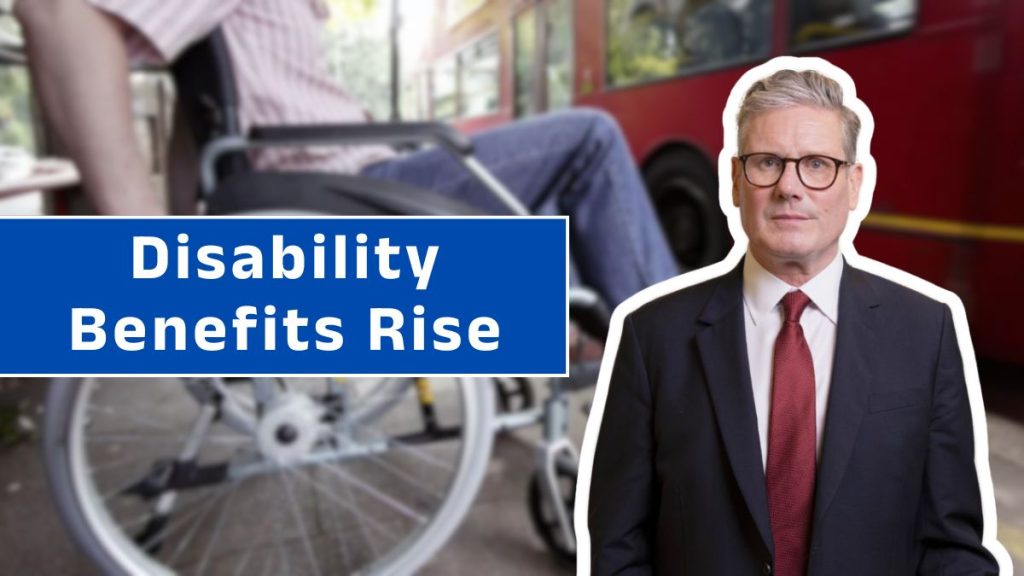The Department for Work and Pensions (DWP) has officially confirmed that disability benefits will rise in 2025, bringing changes to Employment and Support Allowance (ESA), Personal Independence Payment (PIP), and other disability-related allowances. For millions of claimants across the UK, this increase comes as a welcome boost at a time when the cost of living continues to put pressure on household budgets.
Why Disability Benefits Are Increasing

The DWP has stated that disability benefits are regularly reviewed to reflect inflation and living costs, ensuring that recipients do not lose financial stability during times of economic strain.
In 2025, the confirmed increases are based on the Consumer Price Index (CPI) and broader financial pressures — including rising costs of food, fuel, and housing. These adjustments aim to help claimants maintain independence and prevent them from falling behind amid persistently high prices.
Protecting Vulnerable Groups
According to the DWP, the 2025 rise is specifically designed to protect vulnerable households, including individuals with disabilities and long-term health conditions. The department’s goal is to provide financial consistency and ensure those unable to work can still afford daily essentials such as heating, food, and transportation.
The government emphasised that these upratings are part of a long-term plan to support financial security and reduce inequality for disabled citizens across the country.
What Is Employment and Support Allowance (ESA)?
Employment and Support Allowance (ESA) is a key financial support system for individuals unable to work due to illness or disability. It helps cover living costs while allowing recipients to focus on their recovery or manage long-term conditions.
There are two main types of ESA:
- Contribution-based ESA – available to those who have made sufficient National Insurance contributions.
- Income-related ESA – means-tested and aimed at individuals with limited income and savings.
After assessment, claimants are placed into one of two categories:
- Work-Related Activity Group (WRAG) – for those able to undertake work preparation activities.
- Support Group – for claimants with severe or terminal conditions who are not expected to seek employment.
New ESA Rates for 2025
The DWP has confirmed increased ESA rates effective from April 2025, reflecting the cost of living adjustment. The new estimated weekly payments are:
- Work-Related Activity Group: £96 per week (previously £90.50)
- Support Group: £138.50 per week (previously £129.50)
- Basic Component (contribution-based): £89.60 per week
The increase will vary depending on age, health status, and whether the claimant receives other benefits such as Housing Benefit or Universal Credit.
These adjustments are designed to help with essential costs including rent, energy, food, and healthcare, giving claimants a stronger financial cushion through 2025.
What Is Personal Independence Payment (PIP)?
Personal Independence Payment (PIP) supports people aged 16 to State Pension age who face challenges with daily living or mobility due to a disability or long-term health condition.
Unlike other benefits, PIP is not means-tested, meaning income and savings do not affect eligibility. Instead, payments depend on how much a disability impacts everyday life.
New PIP Rates for April 2025
From April 2025, all PIP components will see an uplift. The new weekly rates will be:
- Daily Living Component (Standard): £72.70
- Daily Living Component (Enhanced): £108.50
- Mobility Component (Standard): £29.80
- Mobility Component (Enhanced): £79.90
These increases will help cover personal care costs, mobility equipment, and transportation, giving claimants better support to manage independent living.
Increases in Other Disability Benefits
While PIP has replaced most Disability Living Allowance (DLA) claims for adults, some existing claimants and children under 16 still receive DLA. Both DLA and other disability-linked benefits will also increase from April 2025.
The updated rates include:
- Attendance Allowance (Higher Rate): £108.50 per week
- Attendance Allowance (Lower Rate): £72.70 per week
- Carer’s Allowance: £85.70 per week
These uplifts extend support not just to disabled individuals but also to carers and pensioners, recognising the financial pressures faced by families providing daily care.
How and When the Increases Will Apply
The new disability benefit rates will automatically take effect from April 2025. Claimants do not need to reapply or take any action to receive the higher payments.
The increased amount will be reflected in the first scheduled payment after the April adjustment. All updates will also appear in claimants’ online DWP accounts or via letters sent to registered addresses.
Impact on Claimants
For many households, this rise will make a tangible difference. With inflation continuing to pressure essential living costs, higher disability benefit rates provide relief by improving financial stability and helping recipients manage bills, transport, and health-related expenses.
Even modest increases can significantly help low-income families reliant solely on disability benefits, easing anxiety over basic needs and allowing greater independence.
ESA and Universal Credit Link
Some claimants receive both ESA and Universal Credit, particularly under transitional protection. In 2025, Universal Credit will also rise, meaning those eligible for both schemes will benefit from a combined uplift.
However, the total increase will depend on personal factors such as household composition, savings, and income levels.
Checking Your New Benefit Amount
Claimants can verify their updated payment details through:
- Their online DWP or HMRC account (updated once new rates apply).
- Official letters mailed by the DWP detailing revised amounts.
- Direct contact with the DWP helpline for clarification if online access is not available.
Staying informed ensures you understand how much more you’ll receive and when it will appear in your payments.
The Importance of Reporting Changes
To receive the correct amount, claimants must report any changes in personal circumstances, such as:
- Change of address or marital status.
- Increase in income or savings.
- Moving abroad.
- Change in medical condition.
Failure to update your information may lead to overpayments, which the DWP can later reclaim. Keeping records current ensures your benefits remain accurate.
How to Apply for Disability Benefits in 2025
For new claimants, the application process for PIP, ESA, or Attendance Allowance remains unchanged. You can apply online, by phone, or through a paper form.
Depending on the benefit, you may be required to complete a Work Capability Assessment or medical evaluation. Supporting documents from doctors or healthcare professionals strengthen your case and ensure a smoother review.
Reactions from Disability Organisations
Disability groups have welcomed the 2025 increase but continue to call for broader reform. Many campaigners argue that while the rise helps offset inflation, it may still fall short of covering real-world costs faced by disabled individuals.
Advocates are urging the government to improve the fairness of benefit assessments, simplify applications, and provide better access to employment for disabled workers.
The DWP, in response, stated that it remains committed to building a more inclusive welfare system and ensuring that every eligible person receives the financial support they deserve.
Looking Ahead to 2026 and Beyond
Future disability benefit adjustments will depend on economic conditions and annual inflation data. The DWP reviews rates every year, with new figures usually confirmed each autumn for implementation the following April.
Experts anticipate that with inflation expected to moderate, 2026 adjustments may be smaller — but consistent with the government’s pledge to protect the living standards of vulnerable citizens.
FAQs on DWP Disability Benefit Increase 2025
Q1. When will the new disability benefit rates take effect?
The increases will take effect from April 2025, and the higher payments will appear in benefit statements soon after that month.
Q2. Which benefits are increasing?
The confirmed uplifts apply to ESA, PIP, DLA, Attendance Allowance, and Carer’s Allowance.
Q3. Do I need to reapply to receive the new rate?
No. All eligible claimants will automatically receive the updated payments without needing to reapply.
Q4. How much is the increase for ESA claimants?
ESA payments will rise to around £96 per week for the Work-Related Group and £138.50 per week for the Support Group.
Q5. Where can I check my new benefit amount?
You can view your updated payment information through your online DWP account or by checking the notification letter sent to your registered address.


















